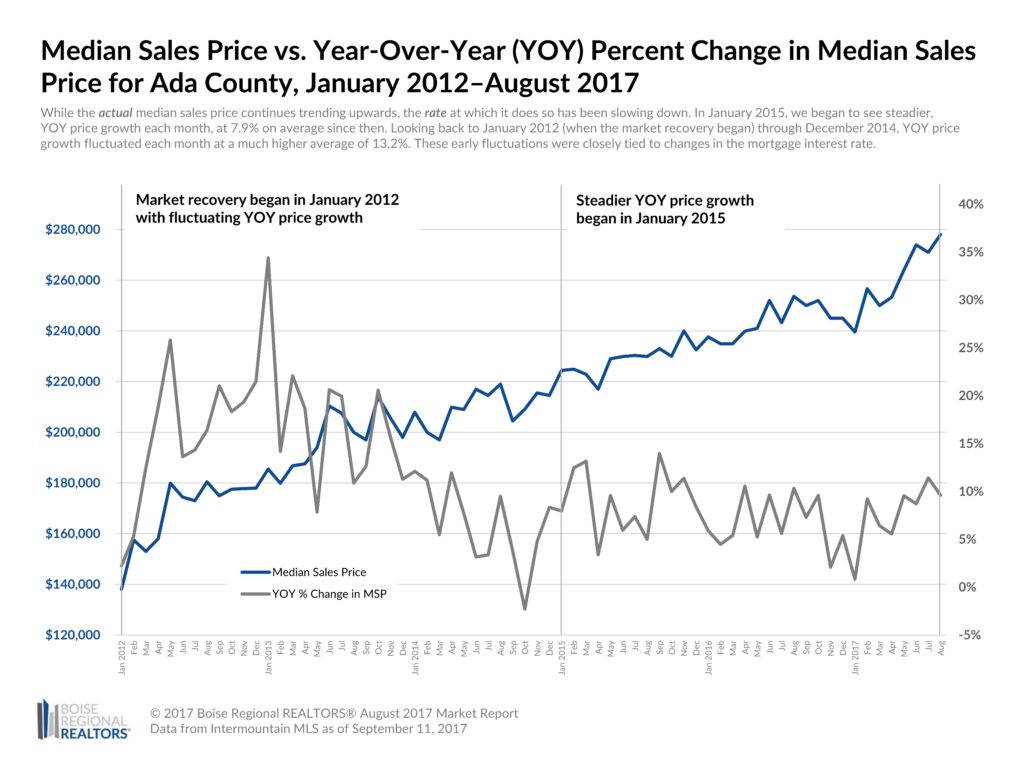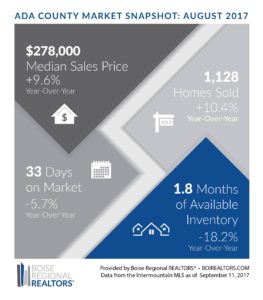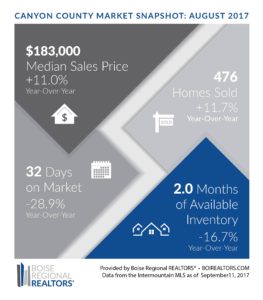Three main factors continue to drive housing demand in Ada County — increased economic development, limited housing supply, and a growing population — resulting in a record high median sales price in August 2017 of $278,000, up 9.6% from a year ago. Yet while the actual median sales price continues trending upwards, the rate at which it does so has been slowing down.
Think of it like driving your car up a hill: as the road gets steeper, the speed at which you drive decreases. You’re still gaining ground, just not as quickly.
In January 2015, the Ada County real estate market began to see steadier, year-over-year price growth each month, at 7.9% on average through August 2017. Looking back to January 2012 (when the market recovery began) through December 2014, year-over-year price growth fluctuated each month at a much higher average of 13.2%.
These early fluctuations were closely tied to changes in mortgage interest rates.
Rising home prices are great for sellers and our economy overall, but eventually, can cause affordability concerns for buyers, even with low mortgage interest rates. Slowing price increases could be an early indicator of the market coming back into balance, but as long as consumer demand outpaces the number of homes for sale, that low supply vs. high demand relationship should keep actual prices moving up.
Canyon County is experiencing the same slowing price growth. From January 2012 to December 2014, the average monthly, year-over-year median sales price increase was 18.9%, compared to the average for January 2015 to August 2017 of 10.5%. The actual median sales price in Canyon County for August 2017 was not a new record, but it was up 11.0% from August 2016 to $183,000.
Additional information about trends within each county, by price point, by existing and new construction, and by neighborhood, are now available in the August 2017 Market Report. This report includes an explanation of the metrics and notes on data sources and methodology.
Download the latest market snapshot graphics for Ada County and Canyon County:
# # #
This report is provided by the Ada County Association of REALTORS®, which began doing business as Boise Regional REALTORS® (BRR) in 2016. BRR is the largest local REALTOR® association in Idaho, with over 4,300 members and two wholly-owned subsidiaries — the Intermountain Multiple Listing Service, Inc. (IMLS) and the Boise Regional REALTORS® Foundation. This report is based primarily on the public statistics provided by the IMLS, available at: intermountainmls.com/Statistics/Static.aspx. These statistics are based upon information secured by the agent from the owner or their representative. The accuracy of this information, while deemed reliable, has not been verified and is not guaranteed. These statistics are not intended to represent the total number of properties sold in the counties or cities during the specified time period. The IMLS and BRR provide these statistics for purposes of general market analysis but make no representations as to past or future performance. || The term “single-family homes” includes detached single-family homes with or without acreage, as classified in the IMLS. These numbers do not include activity for mobile homes, condominiums, townhomes, land, commercial, or multi-family properties (like apartment buildings). If you are a consumer, please contact a REALTOR® to get the most current and accurate information specific to your situation.










Breanna, when you write:
“Three main factors continue to drive housing demand in Ada County — increased economic development, limited housing supply, and a growing population — resulting in a record high median sales price in August 2017 of $278,000, up 9.6% from a year ago.”
Would you give examples of Increased Economic Development?
Thanks for your question, Karen. The resources we turn to on this subject include Boise Valley Economic Partnership (www.bvep.org), the Boise Metro Chamber of Commerce (www.boisechamber.org), Meridian Chamber (www.meridianchamber.org) and the Idaho Department of Commerce (www.commerce.idaho.gov). Under the “Grow’ section at http://news.growideashere.com, there are specific examples of economic expansion and success in the Boise region. Our low unemployment rate is also an indicator of our increased economic development, and you can find more on that here – http://www.indicatorsnorthwest.org/DrawRegion.aspx?RegionID=16001&IndicatorID=14.